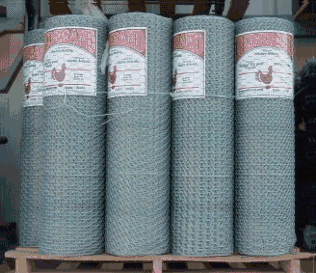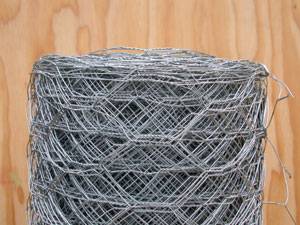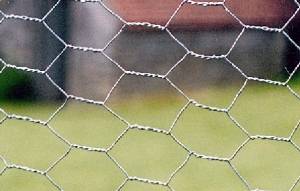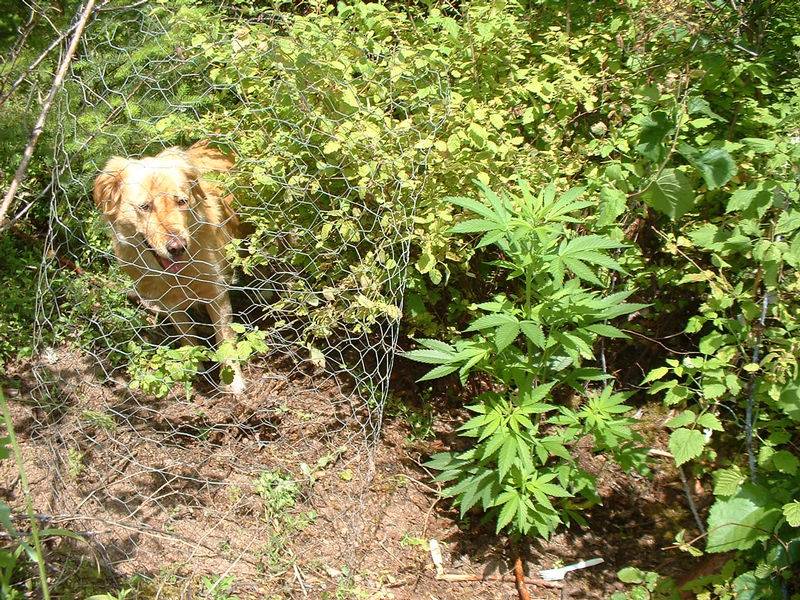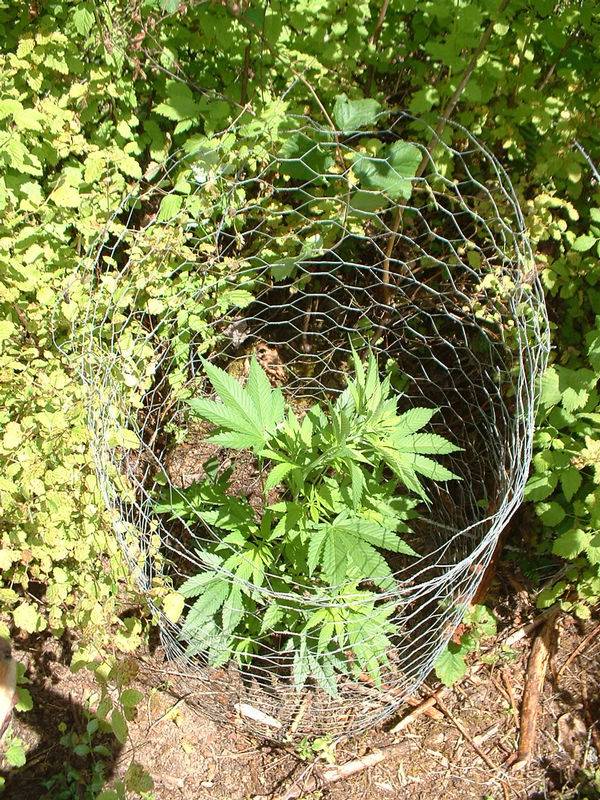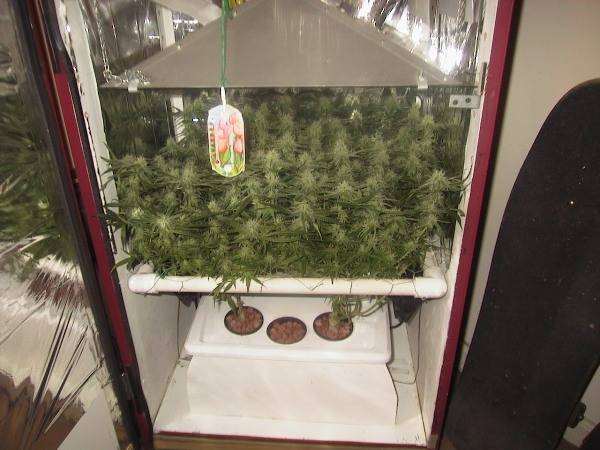Protecting your plants from Deer can be a hot topic for outdoor growers, so I compiled some good info for those it may concern.
Why do Deer eat Cannabis?
Deer are selective in what vegetation they eat, unlike most livestock(Cows, Sheep) who eat mostly coarse grasses. Deer are a high energy predator evading machine, to fuel this machine they concentrate on eating the most nutritious vegetation they can get. Deer tend to eat tender young growth of trees and bushes, the tops of grasses containing young seeds, and other rich tender vegetation and fruits.
In areas with little or no rain during the Summer months, the Deers primary feed can become scarce. In my home of south-western Oregon, the rain stops typically from late June to late September, its not rare to have less than 3" of rainfall during that period of months. During this time, Deer become desperate for rich, moist sources of food, they may start eating things that they would normally pass by. Many of you may have experienced Deer damage in your gardens and landscaping, despite the obvious smell of humans, and even dogs near by. Starvation is a powerfull force.
As a child, I remember my fathers fight with deer who raided our vegtable garden. We used human hair, and various homemade sprays to try and stop them, we even tied our dog in the garden hoping that might help, the sprays didn't phase the hungery deer, and they simply ate up to a few feet of the end of the dogs chain. We eventually built a 9' fence, and that stopped the madness.
How much your plants are in danger, and how well various methods of deterring Deer will work for you depends on how hungery the Deer roaming your area are. If desperate enough, they will eat plants sprayed with nasty tasting stuff, surounded with human urine, or any number of other homegrown or store bought deterrents. When Deer deterrents are tested by Agricultural researchers, the effectiveness is messured in percentage of damage, not complete lack of damage. Over and over again, the only proven method of stopping Deer damage is fencing.
Some growers provide no protection for their plants, and they may not need to if they live in a climate where it rains in summer, the Deer will probably concentrate on their normal food. I also think this is the reason some old standbys like Human hair(and urine), Mothballs, and Soap seem to work for some folks, if the Deer are fed well already, these deterrents may be all that is needed, but I can assure you they will not work in my dry summer climate. I have to depend on fences/cages.
Many outdoor growers shun fences as a secrity risk, considering wire fencing is not vegetation, and may stand out like a sore thumb. In my experience, properly conditioned Chicken wire fencing(Poultry netting) actually disappears well into the surounding vegetation(more on that later).
First lets see what some Deer deterrent tests have revealed about their effectivness-
Soap
Bars of soap are used sometimes with varying effectiveness, shavings are spread around the plot or bars are hung from nearby tree branches. Anyone who decides to use this method should avoid soaps with a Coconut oil base, Deer seem to be attracted to them!
Human Hair/Urine
I found no studies evaluating urine, but I did find two that tested hair. The same study that rated the soap above, rated human hair at a 15-34% reduction in damage. A second study giving captive deer a choice between Corn with Human hair and corn without concluded that their was very little difference in the Deers preference, and dismissed it as a effective method.
Considering that Deer regularly raid Human tended gardens, its easy to see that Deer have little problem overcomming our scent if it means a good meal.
Mothballs
Mothballs scored low in tests, the same study that fed it in corn rated it about the same as Human hair.
Predetor urine
Coyote urine rated high compared to most deterrents, it could be assumed urines from other carnivors would also be effective.
Chicken eggs
Sprays made using chicken eggs rate high, the smell and taste of the eggs seems to put Deer off.
Hot sauce
Sprays using hot sauce seems to be moderately effective.
Commercially available spray repellents
Various brands of repellents exist, all seem to be effective in some areas, and can be down right usless in others. Some require frequent reaplications, some can't take the rain, and many are not rated to be used on plants meant to be consumed. Brands include Liquid fence, Hinder, Millers’ Hot Sauce, Deer Stopper, Plant Pro-Tec, and Deer buster deer and & rabbit repellent are all rated safe to use.
As you can see, scent deterents can be effective in some situations, but they are not 100% effective, and effectiveness depends on the ammount of Deer pressure in a given area.
Here are some links-
Colorado state university-Preventing Deer Damage (one of the more informative sites)
Deer damage prevention efforts in Pennsylvania(The study where deterents were fed to capative deer
University of Vermont -DEER DETERRENTS--SCENTS
University of Maryland
Auburn University
Clemson University
Oklahoma state University
Why do Deer eat Cannabis?
Deer are selective in what vegetation they eat, unlike most livestock(Cows, Sheep) who eat mostly coarse grasses. Deer are a high energy predator evading machine, to fuel this machine they concentrate on eating the most nutritious vegetation they can get. Deer tend to eat tender young growth of trees and bushes, the tops of grasses containing young seeds, and other rich tender vegetation and fruits.
In areas with little or no rain during the Summer months, the Deers primary feed can become scarce. In my home of south-western Oregon, the rain stops typically from late June to late September, its not rare to have less than 3" of rainfall during that period of months. During this time, Deer become desperate for rich, moist sources of food, they may start eating things that they would normally pass by. Many of you may have experienced Deer damage in your gardens and landscaping, despite the obvious smell of humans, and even dogs near by. Starvation is a powerfull force.
As a child, I remember my fathers fight with deer who raided our vegtable garden. We used human hair, and various homemade sprays to try and stop them, we even tied our dog in the garden hoping that might help, the sprays didn't phase the hungery deer, and they simply ate up to a few feet of the end of the dogs chain. We eventually built a 9' fence, and that stopped the madness.
How much your plants are in danger, and how well various methods of deterring Deer will work for you depends on how hungery the Deer roaming your area are. If desperate enough, they will eat plants sprayed with nasty tasting stuff, surounded with human urine, or any number of other homegrown or store bought deterrents. When Deer deterrents are tested by Agricultural researchers, the effectiveness is messured in percentage of damage, not complete lack of damage. Over and over again, the only proven method of stopping Deer damage is fencing.
Some growers provide no protection for their plants, and they may not need to if they live in a climate where it rains in summer, the Deer will probably concentrate on their normal food. I also think this is the reason some old standbys like Human hair(and urine), Mothballs, and Soap seem to work for some folks, if the Deer are fed well already, these deterrents may be all that is needed, but I can assure you they will not work in my dry summer climate. I have to depend on fences/cages.
Many outdoor growers shun fences as a secrity risk, considering wire fencing is not vegetation, and may stand out like a sore thumb. In my experience, properly conditioned Chicken wire fencing(Poultry netting) actually disappears well into the surounding vegetation(more on that later).
First lets see what some Deer deterrent tests have revealed about their effectivness-
Soap
Bars of soap are used sometimes with varying effectiveness, shavings are spread around the plot or bars are hung from nearby tree branches. Anyone who decides to use this method should avoid soaps with a Coconut oil base, Deer seem to be attracted to them!
In the only University study I could find, soaps rated a 34% reduction in Deer damage, not great, but not bad. It may work well in places with low Deer pressure.University of Vermont Extension Department of Plant and Soil Science said:In the category of offensive scents is one of the easiest controls -- hanging bars of smelly soap in the garden, the stronger the scent the better. I actually buy them in bulk at the grocer, then cut them in half and hang in burlap or cheesecloth stapled to stakes in the garden in early spring. I find they are still scented going into the winter....
Studies actually have been done on soaps to repel deer, finding that those containing coconut oils may attract deer. The repellent factor seems to be tallow, that part derived from animal fatty acids. Studies have also found deer can feed to within three feet of soap in the garden. This means a 100-foot border may need over 30 bars of soap! I tend to use less, one about every ten feet or near special plants, and hope for the best. But then I don’t have high deer pressure either.
Human Hair/Urine
I found no studies evaluating urine, but I did find two that tested hair. The same study that rated the soap above, rated human hair at a 15-34% reduction in damage. A second study giving captive deer a choice between Corn with Human hair and corn without concluded that their was very little difference in the Deers preference, and dismissed it as a effective method.
Considering that Deer regularly raid Human tended gardens, its easy to see that Deer have little problem overcomming our scent if it means a good meal.
Mothballs
Mothballs scored low in tests, the same study that fed it in corn rated it about the same as Human hair.
Predetor urine
Coyote urine rated high compared to most deterrents, it could be assumed urines from other carnivors would also be effective.
Chicken eggs
Sprays made using chicken eggs rate high, the smell and taste of the eggs seems to put Deer off.
Colorado state University said:A spray of 20 percent whole eggs and 80 percent water is one of the most effective repellents. To prevent the sprayer from clogging, remove the chalaza or white membrane attached to the yolk before mixing the eggs. The egg mixture is weather resistant but must be reapplied in about 30 days. See Table 2 for a list of commercially available repellents and their ratings against deer and elk browsing in Colorado
Hot sauce
Sprays using hot sauce seems to be moderately effective.
Commercially available spray repellents
Various brands of repellents exist, all seem to be effective in some areas, and can be down right usless in others. Some require frequent reaplications, some can't take the rain, and many are not rated to be used on plants meant to be consumed. Brands include Liquid fence, Hinder, Millers’ Hot Sauce, Deer Stopper, Plant Pro-Tec, and Deer buster deer and & rabbit repellent are all rated safe to use.
University of Minnesota said:Six repellents were tested in a recent Connecticut study. Generally, repellents were more effective on less preferred plants. Here are the findings:
Big Game Repellent also known as Deer Away, made from putrescent (rotten) whole egg solids was 46 percent effective.
Hinder, made from ammonium soaps of higher fatty acids was 43 percent effective.
Thiram, a bitter tasting fungicide, now commonly used in repellents, was 43 percent effective.
Mesh bags of human hair, collected from hair styling shops, was found to be 34 percent effective. (Hair should be dirty, not collected after a shampoo.)
Magic Circle deer repellent, a bone tar oil which was soaked into 10 by 30 cm. burlap pieces, was 18 percent effective.
Miller Hot Sauce, containing capsicum, an extract of hot peppers, was 15 percent effective.
University of Maryland said:Growers who use repellents should understand some basic principles:
• Repellents do not eliminate browsing, only reduce it; therefore, repellent success is measured by the reduction, not elimination, of damage. If even minimal damage is intolerable, 8-foot fencing is the best option.
• Rainfall will wash off many repellents, so they will need to be reapplied. Some repellents weather better than others.
• Repellents only reduce antler rubbing to the extent that they keep deer out of the area.
• Repellents work by altering deer behavior. Therefore, they work best if used before feeding habits become established in a certain area. Deer establish their feeding habits in the late fall and spring.
• The availability of other, more palatable deer food dictates the effectiveness of repellents. When food is scarce, deer may ignore both taste and odor repellents.
• If you use repellents, do not overlook new preparations, products, or creative ways to use old ones. New products are constantly appearing on the market.
• Growers who are facing a long-term problem should compare the costs of repellents and fencing over time.
• A repellent that works in one area may not work elsewhere, even if the crop and conditions are similar to the first site.
As you can see, scent deterents can be effective in some situations, but they are not 100% effective, and effectiveness depends on the ammount of Deer pressure in a given area.
Here are some links-
Colorado state university-Preventing Deer Damage (one of the more informative sites)
Deer damage prevention efforts in Pennsylvania(The study where deterents were fed to capative deer
University of Vermont -DEER DETERRENTS--SCENTS
University of Maryland
Auburn University
Clemson University
Oklahoma state University

